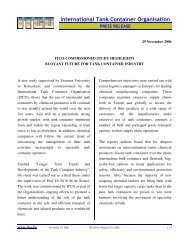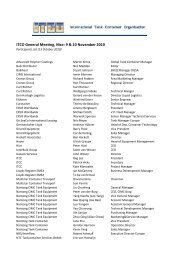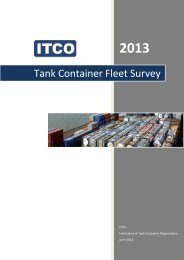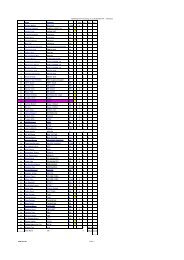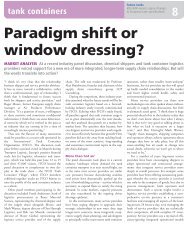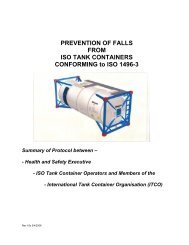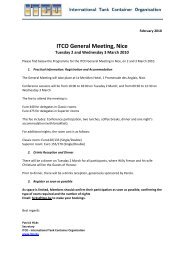Create successful ePaper yourself
Turn your PDF publications into a flip-book with our unique Google optimized e-Paper software.
ICHCA International <strong>Safe</strong>ty Panel Briefing Pamphlet No 30<br />
6.2.4 Pressure Relief Valves<br />
6.2.4.1 Pressure (or combined pressure / vacuum valves) provide safety against<br />
over or under pressurisation conditions in the tank shells. Where the<br />
container is carrying certain specified dangerous goods the pressure relief<br />
valve is fitted with a secondary security feature, the frangible disc, which<br />
prevents an accidental release <strong>of</strong> the cargo’s vapour.<br />
6.2.4.2 The degree <strong>of</strong> filling requirements (see Annex 2 section A2.2) ensures that<br />
there is always a vapour space at the top <strong>of</strong> the pressure vessel so that the<br />
pressure relief valve is exposed to the vapour only.<br />
6.2.4.3 The pressure relief valve is protected from swipe damage by the spill box<br />
where fitted.<br />
6.2.5 Airline Valves<br />
6.2.5.1 When not in use airline valves are blanked or capped <strong>of</strong>f to prevent<br />
accidental operation <strong>of</strong> the valve.<br />
6.2.5.2 The airline valve is protected from swipe damage by the spill box where<br />
fitted.<br />
6.2.6 Top Discharge Openings / Valves<br />
6.2.6.1 When not in use top discharge openings and valves are blanked <strong>of</strong>f to<br />
prevent accidental operation <strong>of</strong> the valve.<br />
6.2.6.2 The top discharge fittings are protected from swipe damage by the spill box<br />
where fitted.<br />
6.2.7 Bottom Discharge Valves<br />
6.2.7.1 The bottom discharge valve comprises <strong>of</strong> two or more separate and serial<br />
closure methods as described in section 5.4.1. All pressure vessels are<br />
fitted with an internal foot valve that can retain the contents <strong>of</strong> the pressure<br />
vessel without any additional closure. External valve devices, such as the<br />
ball or butterfly valves which provide the secondary closure device, are<br />
attached to the pressure vessel using fittings that are designed to fail without<br />
damaging the pressure vessel.<br />
6.2.7.2 It is <strong>of</strong> great importance that containers<br />
carrying hazardous cargoes are fitted with<br />
the correct bottom discharge valve<br />
combinations. The internal foot valve must<br />
be fitted and closed during transport<br />
otherwise damage to the external valves<br />
can result in the cargo being accidentally<br />
discharged. Picture 44 shows an example<br />
where the internal valve should retain the<br />
cargo following the shear section breaking.<br />
Picture 44<br />
Note: Should a shear force be applied to the bottom discharge assembly<br />
there is a risk that a small quantity <strong>of</strong> the cargo may be released.<br />
Therefore when handling tank containers every effort should be<br />
made to ensure that the tank container is landed on level surface<br />
free from objects that are likely to damage the bottom valve<br />
assembly.<br />
Page 24 ©ICHCA International Limited



